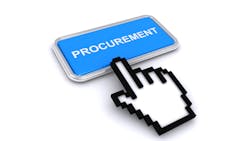Download this article in PDF format.
In an era where minimizing physical contact between people and inanimate objects has become a crucial part of staying healthy, the “touchless” movement is officially in full swing. And while it may have already been gaining traction pre-COVID, the technology that’s operated by means of gestures—instead of requiring a user to touch a keypad, screen or some other device—is gaining ground in many business areas right now.
Procurement is one area that’s ripe for more touchless technology. This not only includes tools that reduce the need for human “touches,” but also the platforms that can help streamline procurement, automate processes and help buyers leverage the power of data analytics.
According to Ivalua, “touchless” in the procurement context basically means that data is electronic (versus recorded on paper, on a spreadsheet or some other manual technique), and that transactions match the first time without the need for human intervention.
Adopting touchless technology helps procurement departments reduce error rates and rework; gain more control and transparency over processes; quickly locate misplaced or lost records; and speed up the PO generation and ordering process. Combined, these benefits result in a more efficient, optimized procurement process.
“Fully automated, touchless processes lead to better PO compliance, invoice automation and invoice-less processing, high first-time-match rates, and more on-time payments,” Ivalua adds. “This metric also impacts others like speed, visibility, and cost savings, and is key to measuring efficiency and effectiveness of the procure-to-pay process.”
Automating Mundane Tasks
According to Manufacturing.net, a touchless supply chain requires little to no human intervention in order to function. As such, it requires a major shift away from traditional, labor-intensive procurement setups. “Traditionally, supply chains have required a great deal of cognitive brain-power and oversight,” the publication points out. “At every stage in the chain, human staff members have been right there, executing tasks and overseeing the smooth functioning of the chain. This supply chain oversight has accounted for thousands upon thousands of staff hours.”
With a touchless supply chain, back-office processes like PO generation are automated to the point where humans no longer have to be hands-on with every step. Like other automation platforms, a touchless one can be programmed to trigger problems, thus allowing procurement to manage by exception (versus having to individually review all steps along the way). This helps eliminate human error while freeing up the procurement department to focus on more value-added projects.
“Moving toward a touchless supply chain is a guaranteed way to future-proof an enterprise against future disruptions,” Manufacturing.net states. “The quicker that companies can remove human intervention from the functioning of their supply chains, the better off they will be. And starting with the core business documents that currently swallow up the most human hours is the sensible and impactful place to begin.”
Early Adopter
In “How SATS is streamlining procurement,” Computer Weekly tells how one airline logistics provider in Singapore recently rolled out a touchless procurement initiative meant to drive inefficiencies out of the purchase order generation process. The company is currently implementing an e-procurement system that, once integrated into its enterprise resource planning (ERP) platform, will help it achieve improved synergies across the supply chain.
For example, demand planning can be integrated with e-procurement to activate procurement of goods in the event of a contingency (i.e., when key supplies from a specific country are cut, like what we saw during the early stages of the pandemic).
“We will have one dedicated system, and all the necessary modules are going to be within one software,” Alfred Aloysius, SATS’ head of global sourcing, told Computer Weekly. “That will allow us to [synergize] processes and have good visibility of procurement activities, and make sure that the service level to our internal customers is good.”
About the Author

Bridget McCrea
Contributing Writer | Supply Chain Connect
Bridget McCrea is a freelance writer who covers business and technology for various publications.







